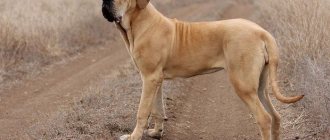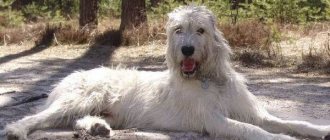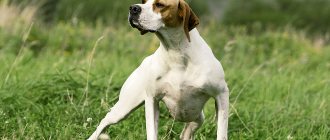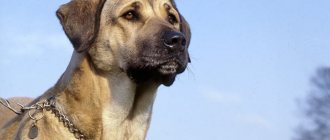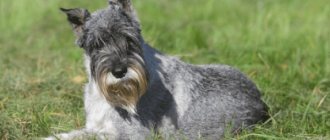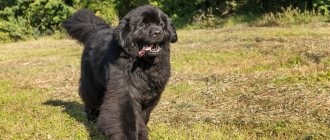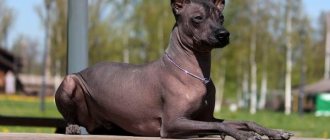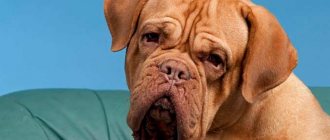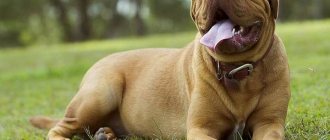History of the Moscow Watchdog breed
Moscow Guard Dog
The breed owes its birth to the Soviet kennel “Krasnaya Zvezda” and the acute shortage of canine personnel caused by the Second World War. At the end of the 40s, the management of the military dog breeding school received a state order to breed a dog that would combine the features of a guard and defender and could serve in extreme climatic conditions. Despite the fact that the breeding base of the nursery at that time was extremely small and consisted mainly of trophy animals exported from Germany, Soviet breeders managed to accomplish the almost impossible. In just a few years, the kennel managed to breed and present to domestic dog handlers not one, but four breeds, including the Moscow guard dog.
Initially, the experiment to create the ideal service dog involved several canine families, including Russian piebald hounds, East European shepherd dogs and St. Bernards. Well, the final touch to the development of the exterior and temperament of the Moscow guard dog was made by Caucasian shepherd dogs. The offspring obtained from the above-mentioned breeds began to be crossed with them in order for them to inherit the natural aggression of their parent.
The first “Muscovites” appeared at the exhibition already in 1950. Six animals - Joy, Despot, Don, Divny, Dido and Dukat - were littermates and turned out to be quite capable dogs, although not without external defects. In 1958, a separate appearance standard was approved for the Red Star dogs, but until 1985 the breed continued to remain officially unrecognized in the USSR. As for foreign cynological associations, for them the Moscow watchdogs are still dark horses. For this reason, these days you can meet “Muscovites” only in the CIS and occasionally in the Czech Republic and Poland, where the breed is run by single breeders.
Interesting fact: the colorful appearance of the Moscow watchdogs is the merit of Orslan, a male who was born in the 60s and is considered the founder of the breed. The first “Muscovites” who took part in exhibitions in the 50s did not look so impressive.
Pros and cons of the breed, application
Some of the most notable advantages of a dog include:
- Devotion.
- Calm character.
- Love for children.
- Unobtrusiveness.
- They can easily get along with other animals in the same territory.
- Developed qualities of a guard dog.
- Good trainability and easy training.
- Developed intelligence.
- The dog can feel comfortable inside the enclosure.
The disadvantages of these dogs are:
- Frequent shedding.
- High food costs.
- It is impossible to keep such dogs in an apartment.
- The desire for dominance.
- Stubbornness.
- Grooming is labor-intensive, and the dog’s health needs careful monitoring.
Appearance of the Moscow guard dog
A formidable giant with the muzzle of a St. Bernard and the shaggy hair of a “Caucasian” - this is approximately the impression the Moscow watchdog makes when first meeting him. By the way, despite the deceptive similarity between the Moscow watchdog and the “alpine rescuers”, there are quite significant differences between them. In particular, the Red Star players, although considered giants among their peers, are somewhat inferior in size to the Swiss. The minimum permissible weight for an adult male Moscow Watchdog is 55 kg, for a St. Bernard - 70 kg. The MC's skull is significantly narrower than that of its Alpine relative, and the transition from the forehead to the muzzle is relatively smooth. In addition, “Muscovites” are distinguished by a stronger constitution and an elongated body, complemented by an amazing ease and dexterity of movement for such giants.
Head
Moscow watchdog with a man
Large, high cheekbones, with a moderately convex, wide forehead, crossed by a longitudinal groove. The muzzle of the Moscow watchdog is blunt and voluminous, noticeably shorter in length than the skull. The infraorbital region is normally filled, the brow ridges and the occipital protuberance are clearly defined.
Lips
“Muscovites” have fleshy lips of a rich black color, without jowls.
Jaws and teeth
The jaws of the Moscow watchdog are massive, with a scissor bite. White teeth in the amount of 42 pcs. fit tightly to each other. The incisors are located along the same line. The absence of several teeth, provided that they were broken or knocked out, is not considered a defect.
Nose
The purebred Moscow guard has a black lobe, very large and noticeably elongated in width.
Eyes
The deep-set, small eyes are tightly covered with black eyelids. The standard shade of the Moscow watchdog's iris is black.
Ears
The correct shape of the ear is triangular, with a softly rounded tip, set above the dog’s eye level. The cartilages support the ear flap in a hanging position, so that the anterior edge of the ear touches the zygomatic area.
Neck
The neck of the Moscow Watch is muscular, of medium length, with a well-developed scruff and moderate dewlap. The latter may be absent in some individuals, which is not considered a disadvantage.
Muzzle of a Moscow guard dog
Frame
Unlike St. Bernards, Moscow watchdogs can boast a more elongated body type. The withers of the “Muscovites” are high and are especially striking in males. The back is strong, of good width, with a short loin and a voluminous, slightly sloping croup. The MC's chest is deep, with convex hoops of ribs that widen towards the croup. The lower line of the abdomen is slightly tucked.
Limbs
“Muscovites” have straight, parallel legs. The shoulder blades are of sufficient length, set obliquely, the shoulders are well muscled. The thighs of representatives of this breed are the same length as the shins. The dog's paws are massive; the front ones are round in shape, with thick elastic pads, the rear ones are more reminiscent of an oval. The animals' dewclaws are removed.
Tail
The tail of the Moscow watchdog continues the line of the croup and is quite thick. In a relaxed animal, the tail drops down, forming a slight bend at the tip; in an excited animal, it takes the shape of a crescent and rises above the back.
Wool
Moscow watchmen
The coat of the Moscow watchdog is abundant, double, consisting of guard hair and thick undercoat. The most stylish appearance is distinguished by males, whose decorative coat forms a spectacular collar on the neck and flirtatious feathering on the back of the legs. The Moscow guard bitch's "outfit" is much more modest due to the smaller amount of hair.
Color
White with red, red-black, black-red or sable spots. Colors that do not have a red tint in any of the listed variations are considered non-standard. In addition, the dog’s chest, tip of the tail and paws (front to the elbow joint, rear to the shins) must remain white. The head of the Moscow guard is framed by a black “mask”, complemented by the same “glasses”. The ears of representatives of this breed are also black.
Disadvantages and possible defects of the breed
Disadvantages that an animal will not receive at an exhibition are:
- excessively long neck with too much dewlap;
- ears in a semi-erect position;
- short tail, curled into a ring or hook;
- shoulder blades too short;
- a narrow head with an overly smoothed or, conversely, sharp stop;
- pendulous, pocket-shaped lips;
- very light color of the iris, obliquely set eyes;
- insufficiently wide feet;
- proximity of the hock joints;
- curly and curly hair (light wave is acceptable);
- square body;
- asymmetrical muzzle color;
- insufficient growth.
Moscow guards with the following physical and mental disabilities are subject to complete disqualification:
- nervousness, cowardice;
- congenital lack of teeth (broken and knocked out teeth do not count);
- amble;
- brown color of eyelids and earlobes;
- distorted jaw;
- malocclusion;
- disagreement.
Dogs with dewclaws, cryptorchidism and unbalanced, loose movements are also rejected.
Kinds
There is only one species - the Moscow Shepherd guard dog , but to consolidate the differences with relatives, a few words about the ancestors.
- Caucasian Shepherd Dog. One of the breeds bred in Russia. Or rather, it originates from antiquity, from the Molossians, but breeding work began at the beginning of the 20th century. The range of modern dogs is areas close to the Caucasus Range. Height at the withers is up to 75 cm, weight up to 70 kg, but can reach up to 110 kg. Considered one of the largest dogs in the world.
The coat is thick, with undercoat. There are three varieties: long-haired, medium-haired and short-haired. The fur color is closer to wolf, gray-brown-fawn. The ears must be cropped, since the dog’s main job is as a shepherd, protecting the herd from predators. And the ears get in the way in a fight.
The character is courageous, decisive, distrustful of strangers. Distinctive qualities are fearlessness and anger. But the owner is the most important being in his life. The dog is literally ready to give his skin for him.
Caucasian Shepherd, one of the largest dog breeds
- Saint Bernard In appearance, the Muscovite is most similar to this breed. But it weighs a little less. The difference in height is not very noticeable, the Swiss at the withers is up to 70 cm, but his weight is much greater - by 10-15 kg. The name comes from the monastery of St. Bernard in the Alps. There is information that this monk organized a shelter for lost wanderers in the mountains. And local dogs helped him find travelers frozen in the snow.
Subsequently, the monks of that monastery often used the “dogs of St. Bernard” to detect people in avalanches. And now the main purpose of the dog is as a search and rescuer. After an avalanche, the St. Bernards are provided with the necessary equipment, food, water, clothing, and sent to look for people in the thick snow. And they really saved the lives of hundreds of victims. This is largely due to the dog’s glorious character. He is obedient, devoted, loves all people, and is very careful in his handling.
The St. Bernard is very similar in appearance to the Moscow Watchdog, but the breeds also have differences
Photo of the Moscow guard dog
Character of the Moscow guard dog
The calculation of the Red Star specialists that their pets would inherit the aggression and impulsiveness of Caucasian wolfhounds was only partially justified. Yes, the Moscow watchmen are brave and courageous, but they are by no means evil and certainly not reckless. The dog will enter into conflict with anyone only when the enemy clearly demonstrates his own intentions. And yet the character of the Moscow watchdog is largely determined by genes. In particular, individuals with predominant blood of “Caucasians” demonstrate greater suspicion and ferocity. They are easy-going and much more suitable for the role of fearless bodyguards. Dogs that have inherited the St. Bernard's temperament are noticeably more phlegmatic, which is why such Moscow watchdogs are more often recommended for the role of family pets and guardians of the owner's wealth.
Raising a Moscow Guard Dog
Moscow watchmen are quiet and only speak when necessary. If your shaggy giant grumbles, it means he really got fed up. In a family, the dog behaves quite peacefully: this is due to the innate ability of “Muscovites” to become attached to people with whom they have to share a common territory. The Moscow watchdog also does not have any friction with children, however, provided that these are not the neighbor’s kids who ran in by chance. A properly raised animal will look at such guests with at least indifference, and even with outright dissatisfaction.
On the Internet you can find a lot of video evidence that Moscow watchmen make hyper-responsible nannies. But in reality, not everything is so simple. Of course, the “Muscovite” will be happy to take your heirs for a ride on a sled, play tag with them and even try to forgive them for minor pranks, but it’s still not worth going away for a long time and leaving foolish kids with such a giant. As an example: a random flick of the tail of this shaggy security guard can knock a three-year-old naughty boy off his feet.
Moscow watchdogs treat each family member equally equally. They do not divide household members into favorites and episodic characters and try to listen to each of them. But this does not mean that the MC is not able to guess who exactly is in charge in the house. Quite the opposite - a pet living in a family is always aware of who has the last word.
Moscow guard dog with a child
Description and features
The Moscow Watchdog is often confused with the Caucasian Shepherd or St. Bernard. This is no wonder, because both of the above breeds are its progenitors. And the dog inherited many traits from them. However, there are noticeable differences. They differ in coat color from Caucasians, and from St. Bernards in their bone structure, muscles and weight.
If you see a large dog of red and white color, with dark tips of the ears and a mask on the face, especially black around the eyes, you know that this is a Moscow guard dog . She doesn’t look like a big, kind dog; on the contrary, she has an outstanding build, well-developed muscles, powerful paws, a confident gait, and an attentive look - all this characterizes a dog of special training.
A kind of special forces among dogs. The Moscow guard dog in the photo looks like a hero, especially against the background of other animals, objects or people. It is impossible to flirt with her, only negotiate. It seems that in her “dog vocabulary” there is only a set of commands. However, hidden within that big body is a noble heart.
Understanding his status perfectly, the dog never shows excessive aggression; it is difficult to start him off like a “Caucasian” ancestor. He fits in well with the family, loves children and reacts calmly to other animals. An obligatory aspect is education, and it should be dealt with by a professional mentor. Then your home and family will be under reliable protection.
Moscow guard dog is an intelligent and friendly breed of dog.
Education and training
A guard dog is a test of the owner's coaching and leadership qualities. Even the most balanced and obedient “Muscovites” are not averse to playing alpha males and wiping their paws on their master’s authority. So from the very first days of the young shaggy dog’s stay in your home, establish a system of permissions and strict prohibitions and do not deviate from the set course until the pet matures.
Moscow guard dog training
Typically, Moscow watchdogs begin to show character at 6 months of age. In particular, adolescents may deliberately not respond to calls for food or may grumble and snarl displeasedly in response to the command. In such cases, the method often used by the mothers of puppies themselves will be effective. The disobedient disciplinarian is knocked down, toppled onto his side, and forcibly held in a supine position until he has properly reflected on his own behavior and calmed down.
Never show your older puppy that his massive jaws scare you. Moscow guard dogs are quite perceptive and will quickly understand that they have “outgrown” your authority. Teasing and provoking a dog, trying to develop guarding skills in it, is also not the best technique. If you regularly try to take away a toy or food from an MS, prepare for such negative bonuses as anger and nervousness.
There are also subtleties in using commands. So, for example, the call “Come to me!” not used for cases when the trainer is going to punish the pet. Not a single dog will voluntarily come up to “distribute gingerbread”, let alone a Moscow guard dog. Ban "Ugh!" They pronounce it in a categorical, threatening tone so that the “Muscovite” does not have the desire to test the owner’s patience. Owners who are raising a future exhibitor will find the “Show your teeth!” commands useful. and “Nearby!”
It’s worth considering taking your dog to a ZKS course if you see your pet as a future bodyguard. If the candidacy of a Moscow watchdog is being considered for the place of a family friend or guard, you can limit yourself to home training. True, it should be dealt with by an adult with a strong character, who has an understanding of the psyche and temperament of the breed.
Reproduction and lifespan
Breeding large dogs is a difficult and very expensive task. Mating begins at 1.5-2 years, there are 6-7 puppies in the litter. Moscow Guard Dog puppies are weighty from a young age, and besides, it is not at all advisable to squeeze them. But this is not the main thing. You are responsible not only for the health of your mother, but also of future heroes.
They need to be shown to a veterinarian, vaccinated, fed, educated, and finally. Only professionals can handle such a respectable dog correctly from the first days, so that in the future there will be no deviations from upbringing. An ignorant owner can cause irreparable mental damage.
You need to be prepared for the fact that a large dog needs a large supply of food
And his viability in the profession will be under threat. The nursery will tell you not to adopt a gentle fluffy puppy, but a distrustful, suspicious puppy who does not immediately fit into your hands. He will then grow into a real service worker. Unfortunately, the life expectancy of the MS, like other large breeds, is short. On average 10-12 years.
Maintenance and care
The impressive build of Moscow watchdogs makes them not the most convenient pets for apartment owners, although some dog owners make such sacrifices. The optimal housing for shaggy giants would be a spacious cottage or a specially equipped enclosure in the courtyard of a private house. Having warm two-layer “fur coats”, MS are well adapted to Russian winters and are quite capable of surviving them in a wooden insulated booth. Typically, a dog “hut” is located in such a way that the animal has a good view of the territory. If you plan to keep it in an enclosure, then the latter must be equipped with a roof, under which the dog will hide from the heat and bad weather.
It is worth mentioning separately about breeding bitches. Enclosures for expectant mothers must be built with reserves, since the Moscow Watchdog is a fertile breed. In addition, it will be necessary to equip a puppy pen, which will be both a “maternity hospital” and a “kindergarten” for future offspring. If your pet lives in a cottage or apartment, find a secluded, bright corner for its bed, protected from drafts and direct sunlight.
Hygiene
Moscow Guard puppies with mother
Having settled the Moscow watchdog in a house or apartment, stock up on combs, combs and a furminator, because the dog will shed twice a year. You don’t need to have super intuition to guess that there will be a lot of hair from this breed (the dimensions are a requirement), so from the first months of life, accustom the puppies to daily brushing. A properly raised child should not shy away at the sight of a brush and slicker or grumble displeasedly at the owner.
During the period between molts, Muscovites are also brushed daily, as their fur often mats. If there is an acute lack of time, it is not forbidden to skip the procedure, unless, of course, the dog’s “fur coat” is in a state of disrepair and twigs, leaves and other debris have not become tangled in it after a walk. You should not get carried away with bathing your pet too often if it lives in the yard. 3-4 bath days per year are enough. Apartment dwellers are washed more often, which is more likely due to the owner’s desire to keep the house clean than necessity.
Once a week, the ears of the Moscow Watchdog are examined and cleaned with a damp cloth or napkin. If traces of nitrous oxide are found in the dog's eyes, they can be removed with a soft cloth soaked in a cooled infusion of tea leaves. It is better to trim the nails of Moscow watchdogs as needed (usually once a month), but this is an option for animals with a low level of motor activity. In MCs who are given plenty of walks, the nail plate wears down naturally.
Walk
The clumsiness and heaviness of the Moscow watchmen are apparent. In fact, representatives of this breed are much more active than their ancestors - St. Bernards, so, alas, it will not be possible to put them in an enclosure and enjoy a quiet life. Owners of apartment animals who suffer the most from physical inactivity will have to work especially hard. You will have to walk these “Muscovites” for at least 4 hours a day, interspersing regular promenades with active games. Two one-and-a-half-hour walks per day are enough for the enclosure inhabitants, but this is provided that the animal moves freely around the territory of the enclosure or garden plot. Keeping a Moscow watchdog on a chain is considered unacceptable.
Important: Moscow Watchdog puppies are allowed to be walked only after two comprehensive vaccinations. Up to a year, the baby is not burdened with long hikes and energy-consuming games, thus allowing the pet’s joints to get stronger.
Feeding
The muzzle of a Moscow guard dog puppy
The standard menu of the Moscow watchdog is lean meat or its trimmings, offal, porridge (buckwheat, rice, oatmeal, millet) and vegetables. Sour milk and sea fish such as navaga and cod should also be present in the dog’s diet. It is useful to start introducing two-month-old puppies to the taste of vegetables. Suitable for this purpose are pumpkin, cabbage, zucchini, tomatoes, potatoes and beets, which are given to children in a slightly stewed form with the addition of unrefined vegetable oil. By the way, Moscow Guard Dog puppies are prone to food allergies, so each new product is introduced into the baby’s diet with extreme caution and in small doses.
Should be avoided:
- mushrooms;
- beans, peas and any other legumes;
- chocolate, sweets and confectionery;
- pasta and baked goods;
- chicken bones;
- river fish;
- hot, spicy and salty dishes.
Moscow guard dogs, who eat only natural food, should additionally be given vitamin-mineral complexes and supplements with chondroitin and glucosamine, which are essential for joints. If you plan to keep your four-legged friend in industrial drying, choose varieties designed specifically for giant breeds, and this should not be economy-class food.
Nutrition
Obviously, such a giant is capable of eating twice as much food as any other dog. Therefore, maintenance will be more expensive. If you were counting on a little one, a Muscovite is not your option. The standard diet is lean meat or meat trimmings, cereals, offal, vegetables, bran and herbs.
Boiled fish and fermented milk products are periodically added to this. Babies begin to be fed cottage cheese, boiled vegetable puree, oatmeal and buckwheat porridge. Each new product is introduced carefully and gradually, due to the danger of allergies.
You should not feed mushrooms, legumes, sweets, flour products, chicken bones, river fish, or hot, salty, and spicy foods at all. Add the necessary vitamins and microelements. If you decide to stop at factory feed, choose an option for large breeds, and a good one at that.
Health and diseases of Moscow guard dogs
The scourge of all large breed dogs – hip dysplasia – has not spared Moscow watchdogs either. The disease is almost always genetically determined and often manifests itself after 4 or more generations, so it is extremely difficult to predict the possibility of its occurrence in puppies even from X-rays. And yet, despite the fact that it is impossible to completely overcome this unpleasant diagnosis, it is quite possible to train your pet to live with it. The main thing is not to limit the animal in moderate physical activity and not allow it to gain excess weight. By the way, about weight indicators: “Muscovites”, who are fed not in accordance with established standards and are treated to delicacies without measure, become fat in a matter of months. You can fight the problem with the same physical activity and a therapeutic diet. But the breed’s predisposition to allergies cannot be cured at all, although veterinarians do not prohibit suppressing outbreaks of the disease with antihistamines.
basic information
| Breed name: | Moscow watchdog |
| Country of origin: | Russia |
| Time of origin of the breed: | XX century |
| Type: | 1 |
| Weight: | 45 – 60 kg |
| Height (height at withers): | 66 – 78 cm |
| Lifespan: | 10 – 13 years |
| ICF classification: | not recognized |
| Price of puppies: | 100 – 400 $ |
| The most popular nicknames: | list of nicknames for the Moscow watchdog |
How to choose a puppy
- The optimal age for a Moscow Guard puppy to move into your home is 7 weeks, but it is better to get to know the pet early in order to be able to monitor its development, as well as changes in behavior and character.
- Visit the baby's mother and evaluate her reaction to your invasion of her territory. If a bitch exhibits shyness and cowardice, most likely the offspring will also inherit these qualities.
- Lively, friendly puppies grow into leaders who, with proper training, turn into stern bodyguards. For those who do not plan to acquire a shaggy dominant, it is better to take a closer look at more modest and soft babies, who make good family pets and responsible property guards.
- Don't grab the biggest puppy in the litter. A lot of weight is an extra load on the ligaments and joints, which are already not the strongest among Moscow watchdogs. The optimal weight of a one-month-old puppy is 3.5 kg (if the litter is large) or 4.5 kg (in a small litter).
- Examine your pet's belly. It should be moderately warm, elastic and without traces of an umbilical hernia.
- Ask the breeder how many siblings your puppy originally had. It’s great if the bitch gave birth to 6 or less “tails”. If there were more babies, they most likely did not have enough mother’s milk.

